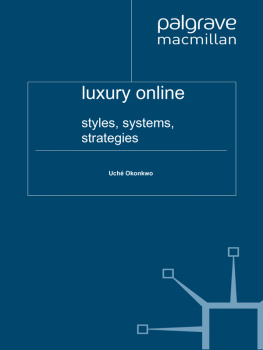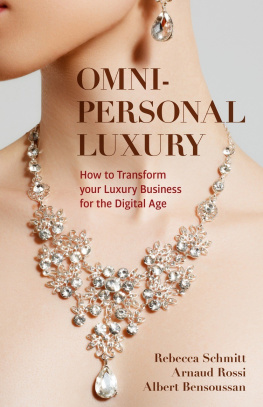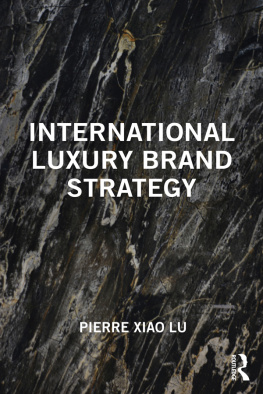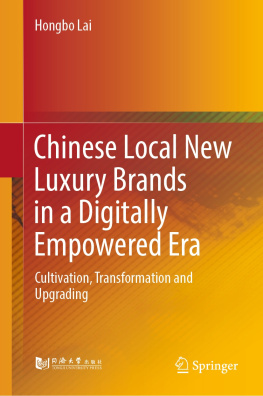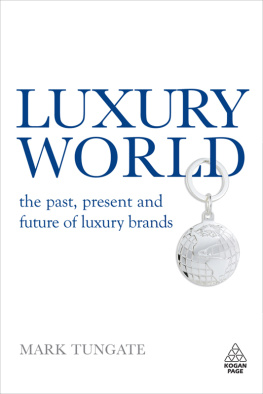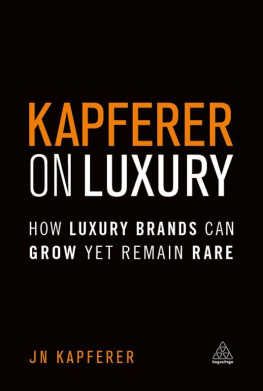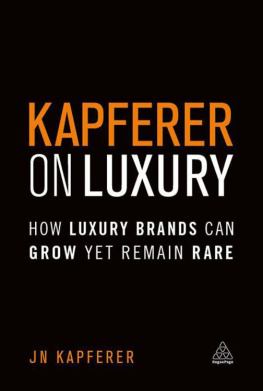luxury online
luxury online
styles, systems, strategies
Uch Okonkwo


Uch Okonkwo 2010
Foreword Mark Dunhill 2010
All rights reserved. No reproduction, copy or transmission of this
publication may be made without written permission.
No portion of this publication may be reproduced, copied or transmitted
save with written permission or in accordance with the provisions of the
Copyright, Designs and Patents Act 1988, or under the terms of any licence
permitting limited copying issued by the Copyright Licensing Agency,
Saffron House, 610 Kirby Street, London EC1N 8TS.
Any person who does any unauthorized act in relation to this publication
may be liable to criminal prosecution and civil claims for damages.
The author has asserted her right to be identified as the author of this
work in accordance with the Copyright, Designs and Patents Act 1988.
First published 2010 by
PALGRAVE MACMILLAN
Palgrave Macmillan in the UK is an imprint of Macmillan Publishers Limited,
registered in England, company number 785998, of Houndmills, Basingstoke,
Hampshire RG21 6XS.
Palgrave Macmillan in the US is a division of St Martins Press LLC,
175 Fifth Avenue, New York, NY 10010.
Palgrave Macmillan is the global academic imprint of the above companies
and has companies and representatives throughout the world.
Palgrave and Macmillan are registered trademarks in
the United States, the United Kingdom, Europe and other countries.
ISBN 978-0-230-55536-5
This book is printed on paper suitable for recycling and made from fully
managed and sustained forest sources. Logging, pulping and manufacturing
processes are expected to conform to the environmental regulations of the
country of origin.
A catalogue record for this book is available from the British Library.
A catalog record for this book is available from the Library of Congress.
10 9 8 7 6 5 4 3 2 1
19 18 17 16 15 14 13 12 11 10
Printed and bound in China
This book is dedicated to the memory of my grandfather John
Okonkwo, who left great impressions on me, even as a child
Contents
List of tables and figures
Tables
Figures
List of Case Analyses
Foreword
It was not too long ago that to suggest that the Internet had an important role to play in the rarefied world of luxury was either an act of misplaced bravery or an outright heresy, depending on your point of view. Today, however, all the major players in this sector are falling over themselves in a rush to embrace the online world.
Until recently, the wisdom of using an official company website for anything more than a few bland declarations and a limited online brochure was still being challenged in the boardrooms of luxury conglomerates. Now, after a stampede to set up transactional e-retail websites, luxury brands, often with the self-consciousness of a child arriving at a new school halfway through the term, are looking to attach themselves to every new online phenomenon, from blogging to Twittering via YouTube and Facebook.
So why has it taken so long for the world of luxury to embrace the Internet and new technologies? Blinkered by fears of channel conflict diverting business from their bricks and mortar stores and upsetting their wholesale customers luxury brands had convinced themselves that luxury was different, that it could not be delivered online without being debased and undermined. So the received wisdom was that at best the Internet was irrelevant, at worst an insidious threat. The leaders of the luxury fashion industry therefore either ignored the online world altogether or opted for a half-hearted level of agnostic semi-engagement which left observers from the real world scratching their heads in bemused disbelief.
Luxury brands, for so long dismissive of the need to listen to their customers, had this time been left far behind by these clients. It has taken them a while to realize this. Indeed, it has been left to the pioneering entrepreneurs of the industry, with the vision and self-belief to challenge the received wisdom of the industry heavyweights, to demonstrate this. Their example illustrated that the Internet can be as powerful a force for change and growth in the rarefied world of luxury as it has proved to be in all other sectors of the retail world. Of course, the luxury Internet trailblazers had the advantage of not being encumbered by the legacy of business structures that were preoccupying their established rivals. They also had the sense to look at the wealth of research about the evolution of e-retailing, all of which pointed to the fact that the twin obstacles to delivering a rich luxury experience online conservative consumer attitudes and technological limitations had been melting away quicker than ice-cream on a summers day.
The reticence of the established groups also helped create the opportunity for the new arrivals, of which Faberg is one. The price of a piece of prime real estate on any prestigious luxury street or shopping mall around the world has become prohibitive to all but the wealthiest brands, even before factoring in the cost of building a retail temple grand enough to catch the attention of the passing customer. However, the cost of creating a presence to rival the same companies online is less intimidating. At the same time, the opportunity to offer a user experience and level of service superior to these established rivals has been very real.
These trailblazers have demonstrated, by wholeheartedly embracing the power of todays technology and combining it with traditional retailing skills, that it is possible to provide an online experience that offers a compelling alternative to the traditional location-bound and time-restricted alternative.
It was this opportunity that captivated my team when we set out to plan how to restore Faberg to its rightful position at the pinnacle of luxury. We also saw the foot dragging of many established rivals as an opportunity. We identified the changes in consumer attitudes, accelerated by the early twenty-first-century economic crisis, and understood how these were enhancing the appeal of the Internet as the preferred primary point of interaction between the consumer and brand or retailer, irrespective of the category and price-point. We confirmed from research and practitioners that these trends were even more apparent among high net-worth audiences for whom discretion and convenience were becoming increasingly important considerations. We were excited by the opportunity that developments in software and imaging technology were providing to transform the online user experience into one that replicates the exclusive and intimate world of the high-jewellery salon. We were impressed by the scalability of an online flagship store open to the world 24 hours a day seven days a week from day one. We were attracted by the power of modern CRM software to nurture an enduring and personal relationship with our customers around the world and provide them with a level of service difficult to match with a black book and a telephone alone.
This significant and groundbreaking book explores all these elements and much more, for the first time. It provides invaluable insights to help all those looking to unlock the massive potential of the Internet and new technologies as an invaluable means of enhancing the luxury experience for the customer and the profit potential of its delivery for the provider. I intend to keep
Next page
